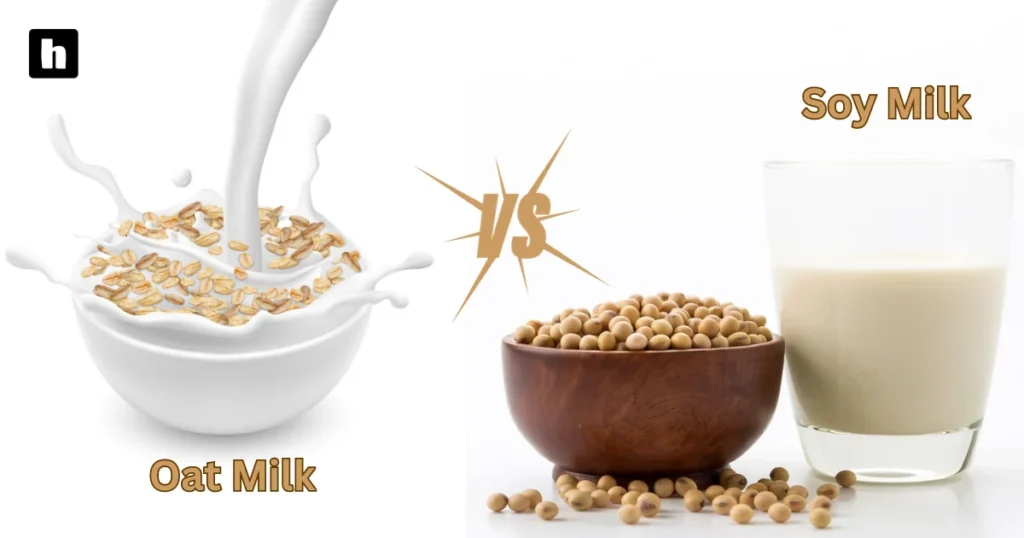
Plant-based milk alternatives have become increasingly popular as more people look for dairy-free options. Oat milk and soy milk are two well-liked choices for those seeking alternatives to dairy products. Both oat milk and soy milk provide creamy textures, enjoyable flavors, and a variety of nutritional advantages. Whether you are contemplating a transition to plant-based milk or are simply interested in learning more about these alternatives, come along as we explore the options and determine which one may be the ideal match for your dairy-free indulgences.
What is Soy Milk?
A plant-based milk substitute made from soybeans is called soy milk. Soybeans are soaked, ground, and boiled before being strained to get rid of any solids. This is how soy milk is made. Because soy milk has essential amino acids and is naturally high in protein, it’s a popular choice for people looking for a dairy substitute that tastes close to cow’s milk.
However, let’s delve further into the intriguing realm of soy milk and examine the complex procedures involved in producing this wholesome beverage.
The Method for Producing Soy Milk
The initial step in the production of soy milk involves soaking soybeans in water overnight. This process serves to soften the beans and eliminate any anti-nutrients. As the soybeans soak, they absorb water and increase in size, resulting in a plump and tender texture. This transformation sets the foundation for the subsequent stages.
Following the soaking process, the soybeans are prepared for grinding. They are ground with water until a smooth paste is formed. This grinding procedure breaks down the soybeans, releasing their natural oils and proteins. The outcome is a creamy and velvety consistency that serves as the base for soy milk.
Next, the soybean paste undergoes a crucial step of boiling. The paste is carefully heated, allowing the flavors to blend and the enzymes to break down. This boiling process not only enhances the taste but also eliminates any enzymes that could impact the texture and stability of the final product.
Once the boiling is complete, the mixture is strained to separate the liquid, which is the soy milk, from the solid particles known as okara. The strained soy milk is then ready to be enjoyed as a refreshing and nutritious beverage.
SUMMARY
Soy milk is made by soaking soybeans in water, grinding them into a smooth paste, boiling them, and separating the liquid from the solid particles known as okara. This process enhances the taste and stability of the final product.
What is Oat Milk?
Oat milk is a popular plant-based milk alternative that is made from oats. It is produced by blending soaked oats with water and subsequently filtering the mixture to separate the milk from the solid components. Oat milk’s smooth texture and naturally sweet flavor have made it more and more popular.
How to Make Oat Milk?
Oats are soaked in water to make oat milk, which is then blended into a smooth consistency. After that, the mixture is strained to get rid of any leftovers, leaving behind a smooth and creamy liquid. You can make oat milk at home without using heat, unlike soy milk, which needs to be cooked. Nonetheless, to extend the mixture’s shelf life and guarantee food safety, commercial oat milk brands frequently heat it.
The process of making oat milk begins with the careful selection of premium oats. After that, these oats are thoroughly cleaned to get rid of any debris or dust. To soften, the cleaned oats are soaked in water for a predetermined amount of time. The starches and enzymes in the oats are broken down during this soaking process, which makes it simpler to blend and extract the milk from them.
The oats are blended with fresh water to create a creamy, smooth consistency after soaking. The act of blending guarantees that the oats are dispersed uniformly throughout the water, resulting in a uniform texture. To extract the liquid from the solid particles, the mixture is then carefully strained through cheesecloth or fine mesh.
In order to get the right consistency for oat milk, straining is an essential step. It aids in removing any last bits of oats, giving the texture a silky, smooth finish. Some people like their mixtures thicker, so they might strain the mixture more than once to get the thickness they want.
After straining, the oat milk can be drunk straight or substituted for dairy milk in a variety of recipes. It can improve the taste and texture of baked goods by adding it to coffee, smoothies, cereals, and baking mixes.
Oat milk vs Soy milk nutrition
Oat milk and soy milk are both rich in essential nutrients and are considered to be some of the most protein-rich plant-based milk options.
Here is a nutritional analysis comparing 1 cup (240 mL) of unsweetened oat milk and unsweetened soy milk (2).
| Nutrients | Soy milk | Oat milk |
| Calories | 100 | 79 |
| Fat | 5 grams | 1.49 grams |
| Protein | 9 grams | 4 grams |
| Carbs | 5 grams | 14 grams |
| Fiber | 1 gram | 1.92 grams |
| Iron | 8% of the daily value (DV) | 6% of the DV |
| Potassium | 8% of the DV | 2% of the DV |
| Calcium | 2% of the DV | 2% of the DV |
In contrast to plain, unsweetened oat milk, soy milk contains slightly more calories, fat, and protein while having significantly fewer carbohydrates. Additionally, soy milk boasts slightly higher levels of potassium and iron.
Both soy milk and oat milk surpass almond and coconut milk in terms of protein content. However, soy milk contains more than twice the amount of protein found in an equivalent volume of oat milk (3, 4).
Oat milk stands out with its higher carbohydrate content when compared to other plant-based milks, such as soy. The reason behind this lies in the fact that oat milk is crafted using whole oats, which are abundant in carbohydrates (5).
Remember that the products provided above are made with minimal ingredients, in contrast to many oat and soy milk products.
For example, the oat milk is made with just oats, filtered water, and salt, whereas the soy milk product mentioned above is made with just water and organic soybeans.
In addition to added sugar and oils, many oat and soy milk products can also be fortified with vitamins and minerals. The addition of all these ingredients could drastically alter the product’s nutritional value.
SUMMARY
Soy milk has more protein than oat milk but less than almond and coconut milk. Oat milk has a higher carbohydrate content due to being made with whole oats, while many oat and soy milk products can be fortified with vitamins and minerals.
Are there any health benefits?
If you use plant milk the way most people do, neither of them will significantly impact your health. That is, on occasion, in your cereal, smoothies, and coffee drinks.
Still, if soy or oat milk is a regular part of your diet, it can add a lot of nutrients to your diet.
For instance, soy milk is a great source of protein, particularly for those on a vegetarian or vegan diet.
A substantial amount of high-quality plant-based protein (9 g) can be found in one cup (240 mL) of soy milk. By contrast, 240 ml, or one cup, of cow’s milk has eight grams of protein (1).
Since protein is the most satisfying macronutrient, soy milk will satisfy you more than other plant milk varieties, such as almond milk (6).
Iron and potassium, which many people worldwide, including Americans, don’t get enough of, are other good nutrients found in soy milk (7, 8).
A potassium-deficient diet can raise blood pressure, which is bad for the heart. Conversely, iron deficiency anemia may result from consuming insufficient amounts of iron through diet (9, 10, 11).
While oat milk is a good source of carbohydrates, which give the body energy, it is lower in these nutrients. In addition, it has some iron in it.
Products made from fortified oat and soy milks have significantly higher concentrations of various nutrients. This is a result of the producers adding vitamins and minerals, like iron, vitamin B12, and vitamin D, to the goods while they are being processed.
A serving size of one cup (240 mL) of Silk fortified soy milk contains 120% and 15% of the daily value for vitamin B12 and vitamin D, respectively (12).
For this reason, if you want to increase your intake of specific vitamins and minerals, fortified plant milk products are a good option.
For example, to make sure vegans are getting enough of certain nutrients like vitamin B12 in their diet, experts advise vegans to drink fortified plant milks like soy milk (15).
Potential drawbacks
Both soy milk and oat milk have potential drawbacks, depending on the product, despite the fact that they may offer some benefits.
A lot of added sugar
You’re probably using a product with added sugar unless you specifically look for unsweetened plant milk products, such as unsweetened soy or oat milk.
To enhance flavor, companies add sugar to their goods. Some make a substantial addition.
For instance, Silk vanilla soy milk has 8 grams or 2 teaspoons of added sugar in a 1 cup (240 mL) serving, whereas Oatly chocolate oat milk contains a staggering 16 grams or 4 teaspoons of added sugar in the same serving size (16, 17).
Regular consumption of these sweetened milks may result in the intake of excessive amounts of added sugar. A diet rich in added sugar has detrimental effects on blood sugar levels and can give rise to health problems such as fatty liver and hypertension (18, 19, 20).
In related news, oat milk has a relatively high overall carb count. If you have diabetes or prediabetes, you might want to opt for lower-carb options like almond or coconut milk, which will not significantly impact your blood sugar levels.
The impact of soy on health
Due to the fact that soy contains substances known as phytoestrogens, some people have expressed concern about the possibility of negative consequences. There is conflicting research on this, though.
Your body’s phytoestrogen receptors bind to the estrogen hormone. They can mimic estrogen’s activity in the body or have antiestrogenic or estrogenic effects, which means they can either block or mimic estrogen’s effects (21, 22).
Some individuals believe that consuming a large amount of soy can potentially elevate the likelihood of specific health conditions, such as breast cancer. However, extensive research fails to substantiate this correlation.
Studies indicate that the consumption of soy is linked to a decreased likelihood of developing breast cancer among Asian women. Additionally, it may also contribute to a lower chance of breast cancer recurrence in both Asian and Western populations (23, 24, 25).
However, there is evidence suggesting that consuming high amounts of soy in one’s diet could potentially have detrimental effects on the endocrine system and disrupt thyroid function (26, 27).
As a result, healthcare experts often advise individuals with thyroid conditions to restrict their consumption of soy-based products, such as soy milk (28).
Pesticide residue in oat milk
Herbicides and pesticides are heavily applied to a wide variety of crops. Glyphosate is a controversial broad-spectrum herbicide that is frequently used on oat crops (29).
Eating foods and drinks high in glyphosate residue, such as oats and cereals containing oats, can expose humans to glyphosate through food and water (30).
When used appropriately, glyphosate has no negative effects on human health, according to the Environmental Protection Agency (EPA) (31).
Nonetheless, some experts contend that high exposure to glyphosate from heavily treated foods may have detrimental effects on a variety of human health issues, including the reproductive system (32).
Scholars contend that insufficient data supports the safety of glyphosate consumption, even at low concentrations, and that more thorough studies are necessary to completely comprehend the effects of glyphosate on human health (32).
Some companies make organic oat milk or offer glyphosate-free products for those who want to reduce their exposure to glyphosate and other pesticide and herbicide residues.
For instance, organic oats are used to make the oat milks from Willa’s, Pacific, and Rise. Organic farming is prohibited from using glyphosate. In addition, some companies, such as Oatly, which do not utilize organic oats, certify that their products are glyphosate-free through independent testing (33, 34).
Additional factors
Soy and oat milks are useful in many different applications. Both of them are well-liked by people who avoid dairy products or follow plant-based diets.
Both can be substituted for milk in recipes for oatmeal, soups, and chia pudding. They are used in drinks like lattes, cappuccinos, and smoothies.
They differ slightly in texture and taste, despite being used in similar ways.
Oat milk is a popular option for coffee drinks like lattes because it is creamier and slightly sweeter than soy milk.
However, because soy milk has a higher protein and fat content than regular milk, barista forums online suggest that soy milk might be a better option for creating foamy coffee drinks.
Soy milk might be a better choice than regular milk if you prefer frothier coffee or tea drinks.
Additionally, oat milk has a lot more carbohydrates than soy milk. Lower-carb plant-based milks, like soy, almond, or coconut milk, may be a good option for those on lower-carb diets or watching their intake.
Finally, whenever possible, opt for plant-milk products that aren’t sweetened. This is due to the fact that plant-based milks that have been sweetened may have a lot of added sugar.
The bottom line
Oat milk and soy milk are commonly chosen as plant-based alternatives to traditional milk in various beverages, such as coffee drinks and smoothies. When comparing the two, soy milk contains higher amounts of calories, fat, protein, potassium, and iron, whereas oat milk is richer in carbohydrates.
Both options can be considered healthy and delicious, depending on individual preferences and health considerations. Regardless of your choice, it is advisable to select unsweetened varieties to ensure that your consumption of added sugars remains within a reasonable limit.


